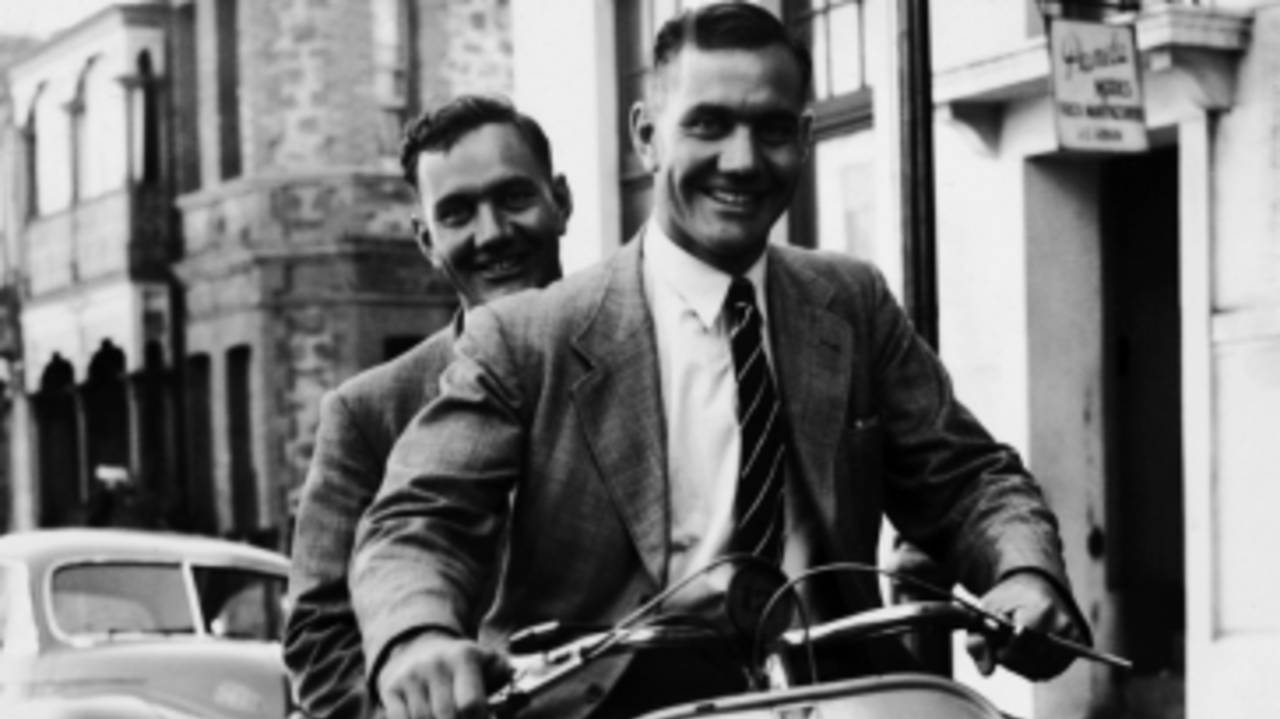A giant of his generation
Alec Bedser was an impressive figure of a man, and his feats with the ball were befittingly large
David Frith
05-Apr-2010

Alec and Eric Bedser in Perth, 1954 • Getty Images
The first thing that struck you about Alec Bedser (who died on Sunday) was his mighty build. It was those huge feet and beefy shoulders that carried England's bowling, usually with quite slim support, from the post-war resumption of Test cricket in 1946 through until the 1954-55 triumph in Australia. By then he was 36, brought low by shingles, and overtaken by the faster, younger Tyson and Statham in captain Len Hutton's estimation.
Bedser was medium-fast, accurate, and a master of variation in the SF Barnes tradition. The ball looked like a snooker ball in his giant hand. He could cut it and seam it, the most lethal delivery the one that curved to leg very late, then spat back to take off stump. That was the ball which, to groans from the stands, sank Don Bradman for a duck at Adelaide in 1947. Unburdened by false modesty, Alec readily spoke with justifiable pride at how he had taken the great Australian's wicket in five consecutive Test innings, twice in the 1948 Trent Bridge Test with late induckers that resulted in catches to leg slip. His wicketkeepers - Arthur McIntyre for Surrey and Godfrey Evans for England - stood up to him because he was so accurate.
My first sight of him was during the 1950-51 Sydney Test, when England had two bowlers out of action, and Alec toiled through 43 eight-ball overs to finish with 4 for 107. Given more favourable conditions, as at Trent Bridge 16 months later, he took 14 for 99 on a damp surface, the start of a record-breaking series (39 wickets at 17.48) with a perfect ending for Hutton's England band: the recapture of the Ashes after 19 years.
Bedser the Lionheart, who had begun his 51-Test career in 1946 with 11 wickets against India in each of his first two Tests, finished with a then world record tally of 236 (24.89). He was just as proud of this landmark as he was scornful of anything he perceived as substandard, either in terms of talent or behaviour. He could even get grumpy at a dinner if a speech didn't meet his essential requirements.
He was scornful of anything he perceived as substandard, either in terms of talent or behaviour. He could even get grumpy at a dinner if a speech didn't meet his essential requirements
A glance at some of his figures in his early Test matches reveals how hard he worked: 2 for 159 in Brisbane, 1 for 153 in Sydney, 6 for 275 in Melbourne during his first Ashes series (1946-47) - punishing experiences that left him undaunted, though he was to spare himself some of the winter tours. Had he not done so, it is unlikely that he would have lasted as long as he did. In old age he could not refrain from sneering at the large cash returns for bowlers who delivered four overs in a Twenty20 match. His viewpoint simply brooked no argument.
Born in Reading, Berkshire on July 4, 1918, Alec Victor Bedser had an almost identical twin, Eric, 10 minutes older. They were practically inseparable through life, until the death in 2006 of Eric, who was a formidable batsman/offspinner for Surrey. They served in the RAF Police during the Second World War, sometimes swapping guard duty without detection. On the beach at Dunkirk during the evacuation in May 1940, had they been a few feet closer to each other in the sand as a German aircraft machine-gunned the helpless British troops, they would both have been killed. It was said that when Alec lost six pounds in body weight after toiling through a baking hot day's play in Adelaide, Eric, who had been sitting in the stand as a spectator, sympathetically shed almost as much.
The Surrey team of the 1950s was probably as strong a non-Test team as the world has known. With batsmen such as Peter May, Ken Barrington and Micky Stewart, bowlers Jim Laker, Tony Lock, Peter Loader and the Bedser brothers, wicketkeeper McIntyre, and the overpowering captain Stuart Surridge at the helm, the county took the Championship seven summers running. AV Bedser had much about which to feel proud.
Later he wrote occasional tour books and newspaper columns in his no-frills style, and continued to devote almost every waking hour to cricket, serving on committees at Lord's, for many years as chairman of selectors, and as tour manager. His knighthood brought with it the predictable wry remark that the last bowler to be knighted had been Sir Francis Drake in the 16th Century.
One of his last "public" appearances was at the 2008 Wisden dinner in London, where he presented Ryan Sidebottom with his special Wisden as a Cricketer of the Year. That thick Almanack looked quite small in the giant's hand, but the voice was now quavering with age and the frail "legend" had to be helped to his feet. Nor was the voice as resonant as it had once been. But the old sergeant-major view of life showed yet again as he said, with a perceivable twinkle in that rheumy old eye, "I'll let you have this book if you get yer 'air cut!"
David Frith is an author, historian, and founding editor of Wisden Cricket Monthly